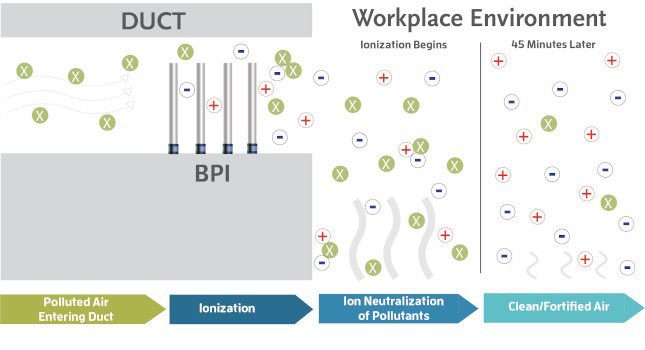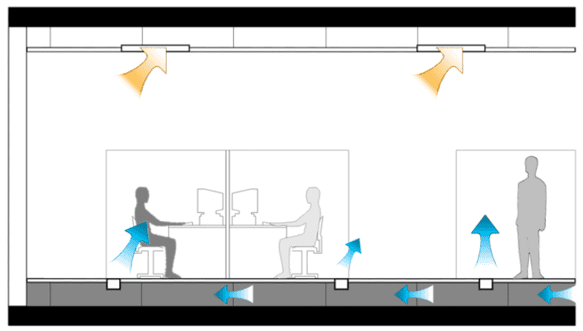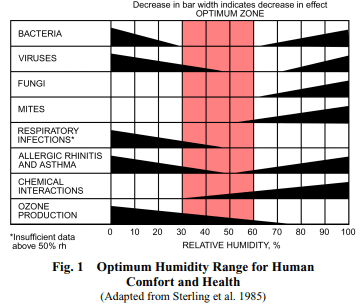The Strang engineering team is not only adopting and evolving design practices in response to the COVID-19 pandemic, but the team is also validating prior design methods. The pandemic has been an opportunity to see the value of many of the design solutions Strang has been promoting, particularly for our pursuit of WELL certification of our office space. Solutions like displacement ventilation, added air filtration, demand-controlled ventilation, and designing for thermal comfort are all examples of design solutions Strang has been developing for projects prior to the onset of the pandemic, which also help to minimize the potential impact of a viral outbreak within an occupied building. In this article, we focus specifically on design solutions to consider in response to COVID-19. Before we do that, first take a look at the infographic below. This is a key resource by ASHRAE that Strang engineers adopt and help to develop alongside their local chapter and industry peers.
DESIGN GOAL - UNDERSTANDING MODES OF INFECTION
Currently, there is no “silver bullet” solution for design and operations of buildings that will stop the spread of COVID-19 amongst building occupants. But there are various methods that can reduce the airborne concentration of pathogens and lower risk of transmission.
In regard to the spreading of COVID-19, the Center of Disease Control (CDC) has released this statement:
“The virus that causes COVID-19 is thought to spread mainly from person to person, mainly through respiratory droplets produced when an infected person coughs, sneezes, or talks. These droplets can land in the mouths or noses of people who are nearby or possibly be inhaled into the lungs. Spread is more likely when people are in close contact with one another (within about 6 feet).”
As this virus is transmitted through the air, our goal as HVAC system designers is to help block certain modes of infection. Take a look at the graphic below. Control of the source is provided by masks and other Personal Protection Equipment (PPE) which will help protect against viral means of entry (i.e. your mouth and nose). Heating, ventilation, and air-conditioning design can help control two other modes of infection: 1. Host susceptibility and 2. Mode of transmission.
“Host susceptibility” relates to occupant well-being. By providing quality ventilation, air distribution, and thermal comfort, occupant health is increased and the risk of susceptibility is lowered. Viral “mode of transmission” can be affected by various HVAC methods including filtration, dilution, and disinfection.
VENTILATION
The impact of green buildings (buildings that reduce or eliminates negative impact and/or create positive impacts, on our climate and natural environment) can help not only with viral transmission, but cognitive function. Their benefits cannot be understated in regard to employee productivity and health. A key aspect of green buildings is increased ventilation. This leads to dilution of the air where the mantra “the solution to pollution is dilution” succinctly sums up the benefit of this practice. The challenge to consider with implementing increased ventilation in your buildings is that creative design solutions are needed to minimize the added energy/carbon costs required to heat, cool, move, and filter the additional air. However, the benefits are worth the challenges. Healthier employees help support host susceptibility.
FILTRATION
Ventilation can reduce your degree of virus exposure by increasing the amount of fresh air that is brought into a space. As the name suggests, filtration involves filtering the air before it is delivered to your space. This creates the same effect of diluting the air by distributing fewer potential viral particles to the occupants of the space. The efficiency of a filter is calculated by its MERV rating (Minimum Efficiency Reporting Value) which evaluates the effectiveness of an air filter at catching particles based on their size. Higher than minimum code filtration is a good recommendation for any building. MERV 8 is code minimum, but MERV 11 or better is recommended. The higher the MERV number, the smaller the particles that are filtered out will be. MERV 13 or higher filters are particularly good at catching particles in the size range that most easily enter our lungs (1.0-3.0) and are associated with a variety of health problems.
Particles produced by coughing or talking that can contain viruses are the hardest to filter out, but you don’t necessarily have to have a perfect filtration system in order to gain a significant benefit in terms of the concentration of viral particles in the air. Retrofitting your HVAC system with MERV 13 or better filters recommended by ASHRAE in the pandemic response guide has been estimated to catch 90-95% of particles in this range.
There is no certain filtration level that has been proven to protect against COVID-19. However, low-efficiency filters (less than MERV8) are very unlikely to make a difference.
AIR DISTRIBUTION
When discussing air distribution let’s start with air change rate. This is the volume of air that’s passed through a room by way of the air handling system. While ventilation (or dilution) supplies more air to a space, it is not always the ideal strategy. The air supplied also needs to be thrown down to the floor level in order to properly condition the space. This air mixing can allow for higher mitigation of viral aerosol. When designing your HVAC layout, you can isolate zones in order to achieve that sought after mixing. However, it’s important to note that this increase of air changes will yes, give you more dilution, but also potentially mix (possibly contaminated) air into more areas of the zone.
A better strategy of air distribution would be underfloor displacement ventilation. This allows the conditioned air to be supplied at the floor level and then be returned in the ceiling. This creates a very low degree of mixing of the air while it is still being conditioned. The air is traveling through the occupied zone but due to the lower amount of air mixing, it lowers the chance of viral/bacterial transmission. Intentional and integrated HVAC systems like this are a key element to the holistic design of spaces and the support of occupant well-being.
TEMPERATURE AND HUMIDITY
There is a narrow range of suitable temperature and relative humidity levels in HVAC design solutions that translate to occupant comfort. Only a small span of temperatures will keep occupants happy. To create the temperatures that would combat viruses and bacteria would also negatively affect any human occupants.
Instead, our focus can shift from temperature to humidity. The human body does a better job at fighting viruses in the optimum zone of 30%-60% relative humidity. That’s why the flu season starts in the fall and winter – when it’s so dry, people’s immune systems don’t react as well.
Now that we’ve talked about how to minimize the virus – how do you neutralize it? There are two ways that are quickly gaining traction in the industry; ultraviolet (UVGI) and bipolar ionization.
DISINFECTION
- UVGI (Ultraviolet Germicidal Irradiation)

With UVGI, the ultraviolet light kills the virus as it passes over the elements through the air handling equipment. The treated air is then distributed throughout the area and to the occupants. The effectiveness of UVGI is dependent on the air making its way back to the unit to be treated, which is why distribution is so critical. However, because it only treats the air as it passes through the system, it does not address the internal surfaces prior to making its way back to the unit.
- Bi-Polar Ionization (BPI)

Bi-polar ionization takes treatment of the air one step further. As the air passes through the air handling unit, ions are negatively charged which allows them to attach to the virus and neutralize it. The treated air is then distributed throughout the area where it continues to neutralize the virus – both airborne and on the surfaces it has passed over.
As previously mentioned, applying methods of filtration, dilution, and distribution of ductwork are highly recommended measures to address indoor air quality. However, when utilizing a bipolar ionization system, it is essential in order to maximize the effectiveness and coverage of the treated air.
While there is a certain time delay for effective neutralization, bipolar Ionization is cost effective, and for a typical residential application, is available with a 24v connection. This means that in most cases it can be connected to your existing furnace control, eliminating the need to hire an electrician. While this process is not new, it is increasing in use as we all race to find solutions for engineered systems in this pandemic.
IN SUMMARY
HVAC plays an important role in minimizing the impacts of the COVID-19 pandemic. Filtration, dilution, and disinfection can help block the mode of transmission while ventilation, indoor air quality, and thermal comfort improve occupant well-being and host susceptibility. These are valuable opportunities that help reduce viral transmission when increasing occupants within a space.
Just like many problems in building design, there is no one silver bullet solution. However, using integrated and coordinated design in combination with one or all of these strategies will only serve to benefit your spaces. And regardless of COVID-19, these ideas are good practices to put into place for the health and wellness of your employees – the heart of your organization.
Written by:















